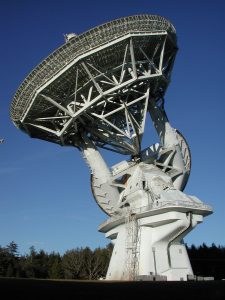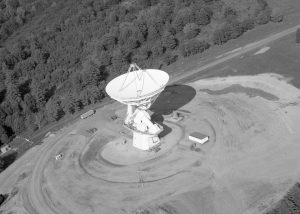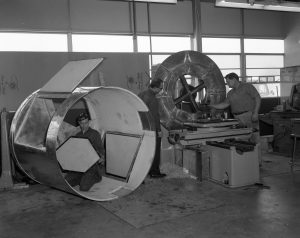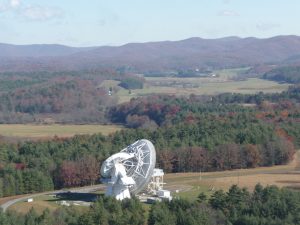The 140-foot telescope in Green Bank, West Virginia is the largest equatorially-mounted telescope in the world. That means that it moves on a gear parallel to the equator of the Earth because it spins on an axis aligned to that of the Earth. In this photo, its two axes of motion are in view. The first is the giant white semi-circular tube with just-visible toothy gears around its edge. This gear is driven by the polar shaft which is aligned to the axis of the Earth. When the Earth turns, this axis turns in the opposite way, to keep the telescope tracked on the sky. The tilting gear is the wedge shape under the 43-meter dish’s support structure.


Unique Radio Telescope
The unique 140-foot telescope in Green Bank, West Virginia stands 200 feet tall. It took six years to design and construct, and then took the astronomical world by storm in its discoveries of organic molecules in space. A 140-foot (43-meter) aluminum-clad parabolic dish antenna sits on the world’s largest polar-aligned mount. The rounded yoke swivels around the central axis of the telescope which is aligned perfectly with the rotational axes of the Earth. In this way, the telescope can easily track objects in the sky as they appear to rise and set from the Earth’s spin on its axis.

First Aerial View of the 140-foot
The unique 140-foot telescope in Green Bank, West Virginia stands 200 feet tall. It took six years to design and construct, and then took the astronomical world by storm in its discoveries of organic molecules in space. This telescope is still operating, but under a more modern name of the 43-meter.

Feed Tower of the 140-foot
When the 200-foot tall telescope in Green Bank, West Virginia needs feed maintenance, operators drive its 140-foot (43-meter) dish to within four feet of the ground and set its parking brakes. An engineering tower is winched on railway wheels until the apex of the telescope is nestled inside. Then, in a protected space, the sensitive equipment can be removed, replaced, and finely adjusted. These days, the 140-foot has not been using a receiver at its apex. Instead, a sophisticated second reflector sits here to bounce waves to receivers nestled in the hole in the center of the dish.

Telescope Converter Parts
Dish-shaped radio telescopes can focus their radio waves directly up to the focus and into a receiver there or use a second reflector at the focus to shoot the waves to a suite of receivers in the middle of the dish. The 140-foot telescope in Green Bank, West Virginia was originally a prime focus type, but in 1974 was adapted into the other type, known as a Cassegrain. In the ever-busy machine shop on site, Basil Gum, Tony Haerl, and Herb Hanes construct casings that will nestle in the throat of the 43-meter dish and safely protect its new receiver family.

Rare Look at 140-foot Maintenance
When the 200-foot tall 140-foot dish telescope in Green Bank, West Virginia needs feed maintenance, operators drive its dish to within four feet of the ground. An engineering tower is winched up until the apex of the telescope is nestled inside. Then, in a protected space, the sensitive equipment can be removed, replaced, and finely adjusted. These days, the 140-foot (43-meter) has not been using a receiver at its apex. Instead, a sophisticated second reflector sits here to bounce waves to receivers nestled in the hole in the center of the dish.





